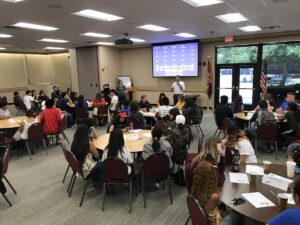As a fifth grade teacher, I always found the first few weeks of a new school year to be overwhelming. In order to manage curriculum planning, day-long meetings, and classroom supplies, I shifted the responsibility of setting classroom rules to my students. Not only did it free up some of my time, doing so also gave my students more ownership of the rules, leading them to be invested in holding themselves and their classmates accountable. Giving voice and power to my students showed them I respected their ideas as we established shared values in our classroom.
Just as my students created our classroom rules, students can be drivers of their school community by engaging in participatory budgeting. Participatory budgeting is a democratic process in which community members decide how to spend part of a public budget, and in schools, this typically involves anywhere from $2,500 to $50,000 of the principal’s discretionary budget. The idea started in Brazil in 1989, where it has shown positive effects, and now is used in cities across the U.S. including Chicago, New York, San Francisco, and Boston. In the latter, youth vote on how to spend $1 million of Boston’s city budget to improve their communities, and have in the past supported free Wi-Fi throughout the city and billboards displaying job opportunities for homeless youth.

High school students from Phoenix, Arizona discuss project proposals for participatory budgeting.
Courtesy of Madison Neanover, Center for the Future of Arizona.
Schools across the country are just beginning to realize the potential of implementing participatory budgeting. Bioscience High School in Phoenix, Arizona recently purchased a sustainability education display in the school’s courtyard, color ink for a student-built 3D printer, and camera adapters for laboratory microscopes. All of these initiatives were generated, debated, and voted on by students. While participatory budgeting can offer many benefits to a student’s educational experience, here are three I especially like:
Participatory budgeting can increase student voice in the school community
Many school districts are structured as a top-down governance model in which decisions are made at the district central office and trickle down to the principals, teachers, and students. This model creates dissonance between decisions and the needs of a community. In participatory budgeting, decision making begins with students and forces a response moving up the hierarchy. Empowering students could cultivate a strong school community, invest students in decisions, and promote a collective effort to improve student experiences.
Participatory budgeting can promote civic engagement and democracy
In our current state of political division, distrust in government, and declining knowledge of civics, it is imperative to promote civic engagement in schools. Civic engagement is more than knowing the three branches of government (many Americans don’t) or how a bill becomes law. Civic engagement requires learning competencies and participatory values that foster an engaged citizenry. Research out of Arizona State University found competencies like public speaking, negotiation, conflict resolution, and budgeting are all taught through participatory budgeting in schools. Students learn to be open to new ideas, participate in robust debate, and recognize the importance of listening to others. As schools place civic education aside for other priorities, participatory budgeting can help fill the gap by building democratic skills and values. Our democracy depends on it.
Participatory budgeting can be fun
Participatory budgeting involves many aspects of school that students find fun. My fifth grade students loved using their creative minds to craft solutions to complex problems. Classroom debates gave my students the opportunity to argue their points based on evidence and reason. Voting on classroom rewards invested them in the academic and social goals they were working towards. (Though be wary that students may vote for messy rewards such as pieing their teaching in the face — see below.) In a time of political division, it is easy to forget how fun democracy can be. If more schools tried participatory budgeting, it could show our nation’s students the joy of democracy.

My students pied me in the face as their classroom reward.
Participatory budgeting is not a silver bullet. Implementation requires thoughtful planning, school and community buy-in, and principal autonomy to use discretionary funds as desired by students. Students should be supported and coached throughout the process just as they are in their classes. Resources are available to help school leaders get started. With strong implementation, I believe participatory budgetings’ potential to empower students, promote democracy, and create fun is a win-win for students, schools, and our nation. Let’s flip governance on its head and empower students to create positive change in their schools.
